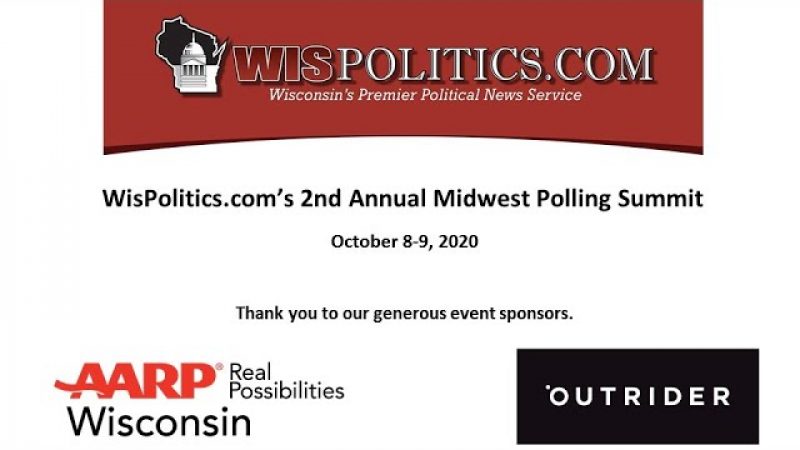Joe Biden leads Donald Trump by three points among likely Wisconsin voters aged 50 and over, according to a poll by AARP and the Benenson Strategy Group and discussed at Day 1 of the WisPolitics.com Midwest Polling Summit.
Forty-nine percent of that demographic backed the Dem nominee while 46 percent favored the president, within the 3.8 percent margin of error. The new poll finds the race is one point closer than in AARP‘s Wisconsin survey last month. That poll had Biden at 50 percent, Trump unchanged at 46 percent.
The poll did not ask about third party candidates — respondents were instead given the option of selecting “other.” Pollster Amy Levin said that designation plus undecided voters made up 5 percent of the survey.
The biggest swing group within that demographic, Levin said Oct. 8 during the first day of the WisPolitics.com Midwest Polling Summitt, was voters aged 65 and over. Levin said Trump won voters in that age group by a 1-point margin in 2016, but they now favor Biden by 11 points.
>> WisPolitics is now on the State Affairs network. Get custom keyword notifications, bill tracking and all WisPolitics content. Get the app or access via desktop.
Still, Trump has made headway with that group since AARP‘s September poll, which found Biden with a 17-point edge among voters over age 65.
Levin says the biggest “jump ball” issue now is the economy.
Respondents in the most recent poll found favored Trump to rebuild the economy by an 8-point margin. But drilling down on specific economic issues like health care affordability, Social Security, Medicare and looking out for middle- and working-class Americans, Biden consistently held an advantage.
“I think there’s the knowledge, and a very ingrained knowledge, that Trump is going to do right by the stock market,” Levin said. “But there’s also, particularly among seniors who have felt so abandoned, not necessarily the belief that Trump is going to look out for them.”
Levin said the campaign that did the best job of framing the economy — whether it be a focus on “the personal side” for Biden or the stock market and other macroeconomic markers for Trump — would be best positioned to win that jump ball.
But Levin said undecided and soft voters only represented a fraction of the 50-plus demographic, adding those voters “are not feeling this great economy” Trump has touted on the campaign trail.
“I think at the end of the day, that’s going to be the deciding ground for most of this very small group,” she said.
The poll was conducted by phone using registered voter lists from Oct. 1 to Oct. 5.
Earlier in the Midwest Polling Summitt, Pew Research Center’s director of political research said national polls show Joe Biden with a stable lead even as the presidential race has been “bombarded” with big news.
Pew’s Carroll Doherty said poll aggregators and his own center’s work show the Dem nominee with a lead of somewhere between 7 and 9 points.
He attributed the stability in part to the lack of prominent third-party candidates. And among those who did vote third-party in 2016, Doherty said Pew data released after the event shows many are “migrating to the Biden camp.”
Along with third-party voters, Doherty agreed undecided voters who in 2016 propelled Trump over the finish line are now distinctly less keen on the president.
“He still runs and acts as if in some ways like he’s an insurgent, but the fact is that this is his record now for the economy and the coronavirus and other issues, and it’s one that voters by and large are taking a negative view to,” Doherty said.
Doherty said Pew’s research showed Trump is the top issue for most voters and the president is driving unprecedented engagement in the election.
“The share who say it really matters who wins is the highest in the 20 years we’ve been polling on that topic,” he said.
That polling shows 83 percent of respondents say “it really matters who wins the election.” That’s up from just 50 percent from the 2000 presidential election that pitted George W. Bush against Al Gore.
Aside from the president, Doherty said other top issues include the economy, which “wraps into” concerns about COVID-19. Voters also are prioritizing health care and Supreme Court appointments.
But on each of those issues and many more, Doherty said the country is seeing “deep polarization.”
“The parties themselves disagree even about the nature of the problems facing the country,” he said.
Still, he warned to be on the lookout for a so-called “October surprise” akin to the FBI reopening an investigation into Hillary Clinton’s use of a private email server in 2016. But he also questioned if the electorate had the capacity to be surprised at this point.
“Given the pace of developments, it’s almost as if voters have come to take it in stride now,” he said. “It’s going to be hard to find an October surprise that will actually move people, unlike in 2016.”



